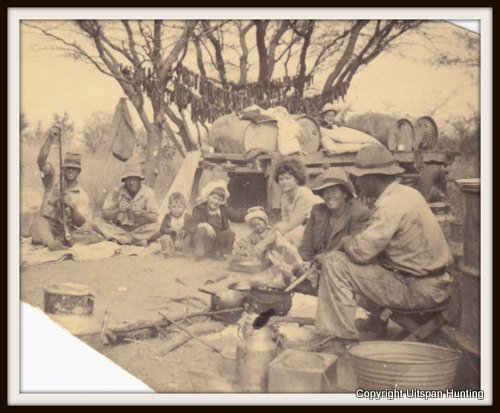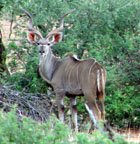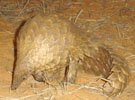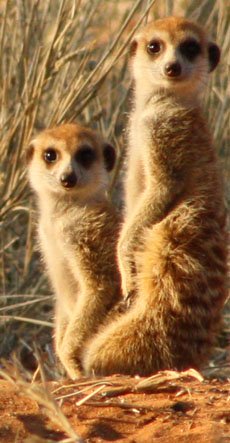For more information about our hunting safaris, don’t hesitate to reach out and contact us!
The Hunter's Moon
by Charlie Burlbaw
(Dallas, Texas)
Have you ever heard in hunting stories about a "Hunter's Moon"? If not - let me share this African hunting story with you.
I met a fellow from Pretoria while there on a work project. After several years of email correspondence and one visit with him and his family, he invited me to come down for a meat hunt. Of course I was to bring my family as well though they were to do a different kind of hunting while he and I were out in the bush... ;-))
We went to a concession in the Northern Cape to hunt kudu, reedbok, (not vaal reedbok though), and springbok. After driving most of the day from Pretoria we arrived at the farmers house where we were to eat and sleep while hunting.
Several of my friends buddies and co-workers were along with us. There was one fellow who was really aggressive with his vehicle (a Land Rover of course), and even drove part way across country on the way to the concession.
The first morning of the hunt found us sighting in our rifles to ensure this yank could hit the broad side of the barn. I did fine and was assigned a PH to go to the field but was cautioned that I could not chamber a round until I was ready to shoot. Apparently hunters in RSA are not much different than those in the US when it comes to gun safety. Better to be safe while stalking and running than sorry.
Around 10:00 hrs, we spotted a small herd of vaal reedbok and watched them until they were out of sight but then we spotted some impala. We were not allowed to shoot impala on this concession as they were not meat animals but trophy game. After an enjoyable morning we all got back together for lunch. While eating lunch, one of the PHs spotted some reedbok up on a hill.
The range was probably a good 350 meters but the Land Rover driver was going to have a shot at one anyway so he climbed up on the top of his vehicle to take a prone shot at one of the rams.
Little did he realize that he was going to join the half moon club! After taking his shot he told us he couldn't tell if he had hit the ram or not as he couldn't see through his scope.
When he turned to look at us, we saw why - In his prone position, shooting uphill, he had gotten too close to his scope and it had blessed him. He had a perfect "hunters moon" over his right eye and the flap of skin was covering his eye. His buddies had a really good time razzing him about joining the half moon club. I noticed that several of them actually had patches on their jackets showing their membership in the half moon club.
We did manage to harvest a couple of small kudu bulls, a springbok and a few more reedbok before leaving. That biltong and drywors is some of the best eating you will ever have.
It really is a shame the USDA won't allow meat products into this country. And it doesn't appear that anyone here in Texas cures meat the way they do in RSA.
Charlie Burlbaw
Comments for The Hunter's Moon
|
||
|
||
|
||
|
||
|
||
|
||
|
||
|
||
Meaning of "Uitspan"
'Uitspan' is an Afrikaans word that means place of rest.
When the Boer settlers moved inland in Southern Africa in the 1800's, they used ox carts. When they found a spot with game, water and green grass, they arranged their ox carts into a circular laager for protection against wild animals and stopped for a rest.
They referred to such an action of relaxation for man and beast, as Uitspan.

(Picture above of our ancestors.)
Did you know? Greater Southern Kudus are famous for their ability to jump high fences. A 2 m (6.56 ft) fence is easily jumped while a 3 m (9.84 ft) high fence is jumped spontaneously. These strong jumpers are known to jump up to 3.5 m (11.48 ft) under stress. |
Did you know? Some animals have one sense more than man!The flehmen response is a particular type of curling of the upper lip in ungulates, felids and many other mammals. This action facilitates the transfer of pheromones and other scents into the vomeronasal organ, also called the Jacobson's Organ. Some animals have one sense more than man!The flehmen response is a particular type of curling of the upper lip in ungulates, felids and many other mammals. This action facilitates the transfer of pheromones and other scents into the vomeronasal organ, also called the Jacobson's Organ.This behavior allows animals to detect scents (for example from urine) of other members of their species or clues to the presence of prey. Flehming allows the animals to determine several factors, including the presence or absence of estrus, the physiological state of the animal, and how long ago the animal passed by. This particular response is recognizable in males when smelling the urine of a females in heat. |


